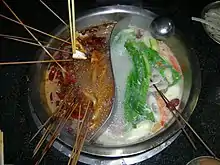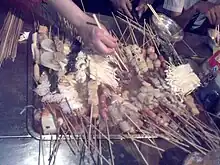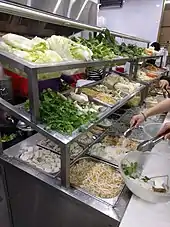Malatang
Malatang (simplified Chinese: 麻辣烫; traditional Chinese: 麻辣燙; pinyin: málàtàng; lit. 'spicy numbing hot [soup]') is a common type of Chinese street food.[1] It originated in Sichuan, China, but it differs mainly from the Sichuanese version in that the Sichuanese version is more similar to what in northern China would be described as hot pot.
| Malatang | |||||||||||||
|---|---|---|---|---|---|---|---|---|---|---|---|---|---|
 | |||||||||||||
| Traditional Chinese | 麻辣燙 | ||||||||||||
| Simplified Chinese | 麻辣烫 | ||||||||||||
| Literal meaning | spicy numbing hot | ||||||||||||
| |||||||||||||
| Part of a series on |
| Chinese cuisine |
|---|
 |
Etymology
Malatang is named after its key ingredient, mala sauce, which is flavored with a combination of Sichuan pepper and dried chilli pepper. The word málà is composed of the Chinese characters for "numbing" (麻) and "spicy (hot)" (辣), referring to the feeling in the mouth after eating the sauce.[2]
Origin
Malatang is said to originate from the Yangtze River near Sichuan. In ancient times, boating was a big industry and many people made a living by towing boats. Working under the damp and foggy weather made boat trackers feel very sick. And when they were hungry, they cooked herbs in a pot and put Sichuan pepper and ginger into the soup to eliminate dampness. Malatang was created, then vendors discovered the business opportunity, and spread it throughout China.[2][3]
Unlike hot pot, which is made to order and shared only by diners at a table, malatang originates from street food cooked in a communal pot. Diners can quickly choose what they wish to eat, and either eat on the spot or take away.[2][3]
Preparation
Skewers

Typically a table with a big and flat saucepan is set up on the street, with a large number of ingredients in skewers being cooked in a mildly spicy broth. Customers sit around the table pick up whatever they want to eat. Given the large number of ingredients available, normally not all ingredients are in the saucepan at the same time, and customers may suggest what is missing and should be added.[2][3]
Customers keep the used wooden sticks by their plates, and when a customer finishes eating, the price to pay is determined by counting the number of empty sticks.[2][3]
By weight


In the mid-2010s malatang shops became popular in North China, especially Beijing. In these shops the ingredients are usually displayed on shelves, and customers pick their desired ingredients into a bowl. Behind the counter the selected ingredients are cooked in a spicy broth, usually at very high temperature for 3–4 minutes. Before serving, malatang is typically further seasoned with much garlic, black pepper, Sichuan pepper, chili pepper, sesame paste, and crushed peanuts. The price is calculated based on the weight of the self-picked ingredients.[2][3]
Common ingredients
Some of the common ingredients include:[4]
- wosun (celtuce)
- beef (chunks)
- dumplings
- lettuce
- spinach
- other mixed greens
- lotus root
- mushrooms
- fresh and instant noodles
- pork liver
- pork lung
- potato
- quail eggs
- Spam
- Chinese yam
- sheep intestines
- numerous types of dried and frozen tofu
- nian gao rice cakes
- beef balls
- fish balls
- chicken balls
- sweet potato
- tripe
Benefits of malatang
Hazards of malatang
At present, many businesses benefit from the trend of adding food additives and poppies that are banned by some countries during the cooking of malatang.[6]
References
- Kraig, B.; Sen, C.T. (2013). Street Food Around the World: An Encyclopedia of Food and Culture. ABC-CLIO. p. 93. ISBN 978-1-59884-955-4. Retrieved July 17, 2017.
- "Malatang". Week In China. 4 September 2020. Retrieved 20 March 2023.
- Lao, Tony (8 July 2019). "Malatang Explained: The Sichuan Street-Food Soup Rivalling Ramen". Broadsheet. Retrieved 20 March 2023.
- "Mala Tang recipe". SimpleChineseFood.
- "临床医生说科普丨麻辣烫有营养吗?". m.gmw.cn. Retrieved 2023-10-06.
- Wu, Hong. "麻辣烫中非法添加罂粟粉,被判刑!_澎湃号·政务_澎湃新闻-The Paper" [Illegal addition of opium poppy powder in Malatang, sentenced!]. www.thepaper.cn. Retrieved 2023-10-02.
